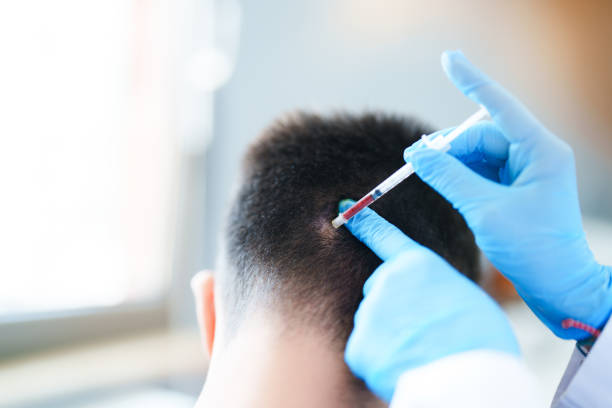Hair loss is a universal concern affecting millions of individuals worldwide. From genetic predisposition to stress and health conditions, various factors contribute to hair thinning and balding. Seeking effective treatments has led to the rise of regenerative medicine, with Platelet-Rich Plasma (PRP) and Platelet-Rich Fibrin (PRF) emerging as promising therapies. Both aim to stimulate hair growth, but understanding their differences and effectiveness is crucial in choosing the optimal solution, particularly in the context of PRP hair treatment.
The Science Behind PRP and PRF
1.Platelet-Rich Plasma (PRP)
PRP hair treatment involves extracting a patient’s blood, processing it in a centrifuge to isolate platelets, growth factors, and plasma, and then injecting this concentrated solution into the scalp. Platelets play a pivotal role in healing and regeneration, releasing growth factors that stimulate tissue repair and cellular growth.
In the realm of hair restoration, PRP is believed to trigger dormant hair follicles’ activation, prolong the growth phase of existing follicles, and enhance hair thickness and density. Its non-invasive nature and relatively minimal side effects have contributed to its popularity as a hair loss treatment.
2.Platelet-Rich Fibrin (PRF)
PRF is an evolution of PRP, distinguished by its fibrin matrix. This matrix, containing a higher concentration of platelets, leukocytes, and growth factors, is obtained through a slightly different centrifugation process that excludes anticoagulants. The fibrin scaffold in PRF extends the release of growth factors, potentially providing longer-term stimulation compared to PRP.
PRF’s higher concentration of growth factors and leukocytes may enhance its regenerative capabilities, aiming for more sustained results in hair regrowth and overall scalp health compared to PRP hair treatment.
The Battle of Effectiveness: PRP vs. PRF
1.Efficacy in Hair Regrowth
PRP and PRF both have demonstrated effectiveness in promoting hair regrowth and improving hair quality. Studies have shown that PRP treatments can increase hair density and thickness, reduce hair shedding, and revitalise inactive hair follicles.
On the other hand, PRF’s extended release of growth factors due to the fibrin matrix suggests potential longer-lasting effects on hair growth. The higher concentration of platelets and leukocytes in PRF may offer a more robust regenerative environment for hair follicles, promoting sustained improvement.
2.Duration and Frequency of Treatment
Typically, PRP treatments for hair loss require multiple sessions spaced several weeks apart for optimal results. The frequency and number of sessions depend on the individual’s response to the therapy and the severity of hair loss. Patients may need maintenance sessions every few months to sustain the achieved results.
PRF, with its potential for longer-lasting effects, may require fewer sessions overall, reducing the frequency of treatments. This aspect could be advantageous for individuals seeking a more convenient and cost-effective solution for managing hair loss.
Factors Influencing the Choice
1.Severity of Hair Loss
The severity and underlying cause of hair loss play a crucial role in determining the suitability of PRP or PRF. For individuals experiencing moderate hair thinning or early stages of balding, PRP treatments might suffice, offering visible improvements in hair density and quality.
In cases of advanced hair loss or a desire for longer-lasting results, PRF might be a more favourable choice due to its potential for sustained effects, requiring fewer sessions overall.
2.Individual Response and Preference
Each person’s body responds uniquely to treatments. While PRP and PRF share similar goals, individual preferences, tolerances, and responses to the therapies may influence the choice between the two. Some individuals might prefer the convenience of more frequent PRP sessions, while others may opt for PRF’s potentially longer-lasting effects despite fewer treatments.
Conclusion
PRP and PRF offer promising avenues in combating hair loss, with both demonstrating efficacy in stimulating hair regrowth and enhancing hair quality. The decision between the two largely depends on various factors, including the severity of hair loss, desired duration of effects, individual response, and convenience.
For those seeking an effective yet relatively faster-acting treatment, PRP hair treatment may be an excellent choice. Its established track record in promoting hair regrowth, coupled with its non-invasive nature, makes it a popular option among individuals experiencing mild to moderate hair thinning.
Conversely, individuals looking for potentially longer-lasting effects and fewer treatment sessions may find PRF to be a compelling choice. The higher concentration of growth factors and extended release due to the fibrin matrix suggest enhanced regenerative potential, catering to those with more advanced hair loss concerns.
Ultimately, consulting with a qualified healthcare professional specialising in hair restoration is crucial in determining the most suitable treatment approach. Their expertise will guide individuals in making an informed decision tailored to their specific needs, ensuring the most effective and optimal solution for combating hair loss.



